Venetia Sherson
13–16 minutes
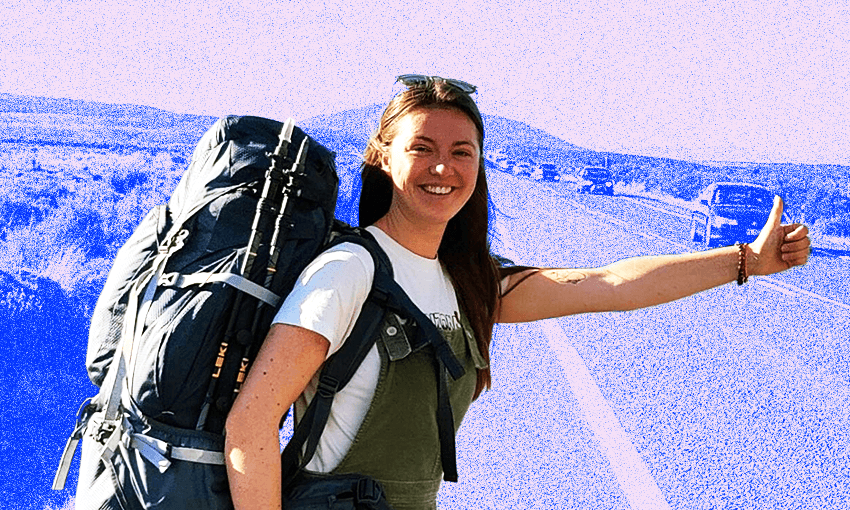
Once upon a time, a generation of free-spirited travellers thumbed their way around the world. In this risk-averse age of instant gratification, does anyone still bother? Venetia Sherson finds out.
At an after-match party for a Coromandel wedding, the subject turned to hitchhiking. Several millennials were present. None had hitchhiked. Most couldn’t imagine why you would willingly get in a car with a stranger to reach your destination. Plus, they had their own wheels. But one man – a 50-year-old Auckland IT consultant – said he loved it, still did it, and would continue to put out his thumb when necessity or the spirit moved him. More about him later. But it raises the question: who else hitchhikes? And why?
Four decades ago, on every motorway junction stood a man or woman with a backpack and a piece of cardboard. New Zealanders on their OE were part of the thousands thumbing lifts on Europe’s roads. Mostly they were young travellers, on a quest to see as much of the world as possible for the lowest possible cost. The rules of engagement were clear: drivers provided free transport; hitchhikers provided company, conversation and tales from other lands. It was an altruistic transaction (possibly the last before words like “bludger” entered our lexicon) between those who had and those who had not.
By the late 1980s that changed. Far fewer travellers put their thumb out. In many parts of the world, hitchhiking appears to be the option of last resort. What killed the noble art?
Fear for starters.
In the act of putting out a thumb, a hiker puts themselves at the mercy of whoever stops to pick them up. The unpredictability of those encounters can be risky for drivers or passengers. Films like The Hitcher, a 1986 horror film about a psychopathic hitchhiker, spooked many drivers. The murders of hitchhikers here and overseas caused parents everywhere to caution their kids to take the bus or train instead. In Australia, Ivan Robert Marko Milat, known as “the backpacker murderer”, robbed and murdered seven backpackers between 1989 and 1992. The Guardian attributed the demise of hitchhiking to the murder in Britain in 1995 of 18-year-old French student Celine Figard.
In New Zealand, high-profile murders also had an impact. Tasmanian teacher Jennifer Beard was murdered in 1970 while hitchhiking to meet her boyfriend in Milford Sound. Mona Blades, 18, disappeared five years later while thumbing a lift from Napier to Tokoroa. Her body was never found. In all, eight people – three men and five women – have been murdered while hitchhiking in New Zealand in the past 50 years. New Zealand police advise against the practice – especially alone. At the inquest into the death of Czech hitchhiker Dagmar Pytlickova, killed travelling to Timaru in 2012, coroner Richard McElrea said, “For your own safety hitchhiking or accepting rides from people you don’t know is not recommended.”
Other factors have played a part. An increase in car ownership is one. New Zealand has one of the highest rates of car ownership in the world (92.1%). Given a fifth of the population are children, this is extraordinarily high. The first major purchase for millennials is a set of wheels, often paid for by their parents, who think it safer for their offspring to drive than take a bus, walk or stick out their thumb. The pandemic also put paid to hitchhiking in many countries. Britain banned the practice in 2020. Other countries strongly advised against car sharing to prevent the disease from spreading.
Long-distance truck drivers – once a godsend for hitchhikers – are also now largely banned from picking them up.
Then there’s the time factor. It can take a long time to get a ride on less busy roads, as Frenchman Cédric Rault-Verpre found when he tried to thumb a lift on New Zealand’s West Coast in 2016. After waiting four days sitting on his backpack, he took out his frustration on the Welcome to Punakaiki sign. He was billed $3,000 for the damage. In a hyper-connected age, where messages can be transmitted in seconds, the prospect of waiting for a lift for even 15 minutes may be too outmoded for younger people.
But the real reason may be more prosaic: with fewer people hitchhiking, the practice now seems strange; at odds with modern life. Whereas in the golden years hitchhiking depended on a sense of trust and mutuality, drivers today are warier. Hitchhikers are viewed with suspicion. They may be seen as bludgers, no different to beggars, exploiting the generosity of hard-working people.
So, has it gone forever? Apparently not in Aotearoa, which still gets the thumbs up as a destination on hitchwiki.org, a website dedicated to hitchhiking around the world.
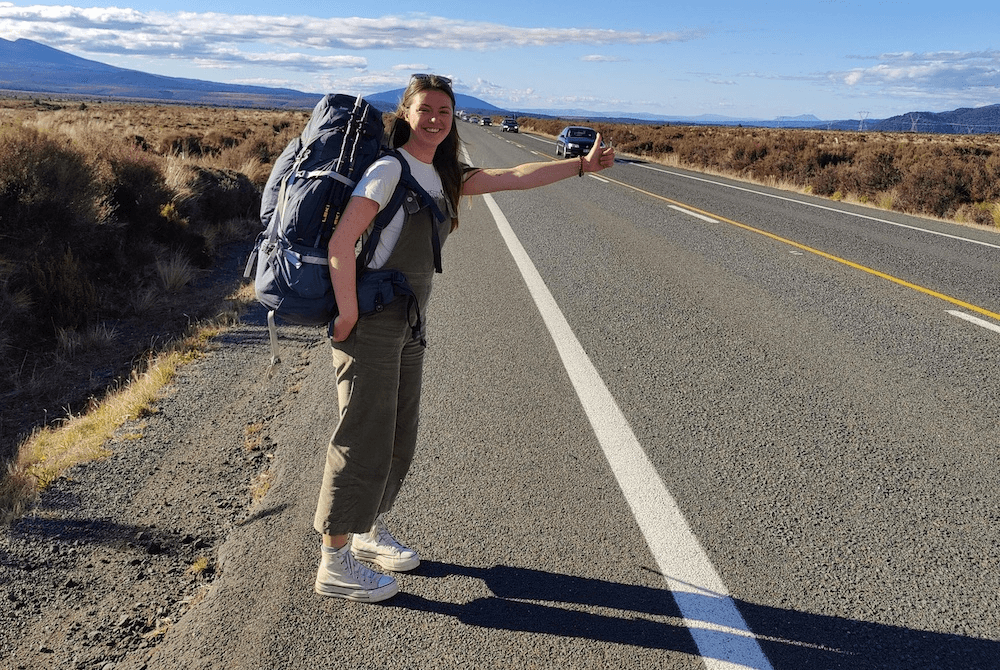
Julie (Photo: Supplied)
Julie Goris is currently thumbing her way around New Zealand’s South Island and loving it. The 25-five-year old Belgian hitchhiker is a travel agent who speaks five languages. She spends half the year organising other people’s travel and the other half hitchhiking in countries she wants to experience for herself.
She arrived in New Zealand in March after hitchhiking in Chile and Argentina. Mostly, she has hitchhiked with a friend, but, in New Zealand, she has largely gone solo. “It’s not about getting a free ride any more. The stories and talks with people who pick me up are a really big part of travelling now.” Drivers who have picked her up include grandmothers, solo drivers who want company, an off-duty bus driver and people who have hitchhiked in the past themselves.
Mostly she has felt safe, “although there was a guy who kept telling me random murder stories, which was a bit weird”. She always asks where the driver is headed and, if she doesn’t like the look of them, she says she is going elsewhere. She also tells them she is being met at the other end.
Longest wait for a ride: One hour in the rain in Iceland.
Best story: “I was hitching in Portugal when I was around 19, travelling with a friend. We got dropped off at a small town with no accommodation so we had to carry on. Two cars stopped. One driver looked scary; the other nice, so we went with him. He said we should not be on the road as it was getting dark and we could stay at his place. He said he would take us to the local bar so people could vouch for his character. They did, including the bartender, who claimed she was a witch. We slept the night in his kids’ bedroom surrounded by pink castles and toys. He made a great Asian dinner for us and the next day put us back on the road again.”
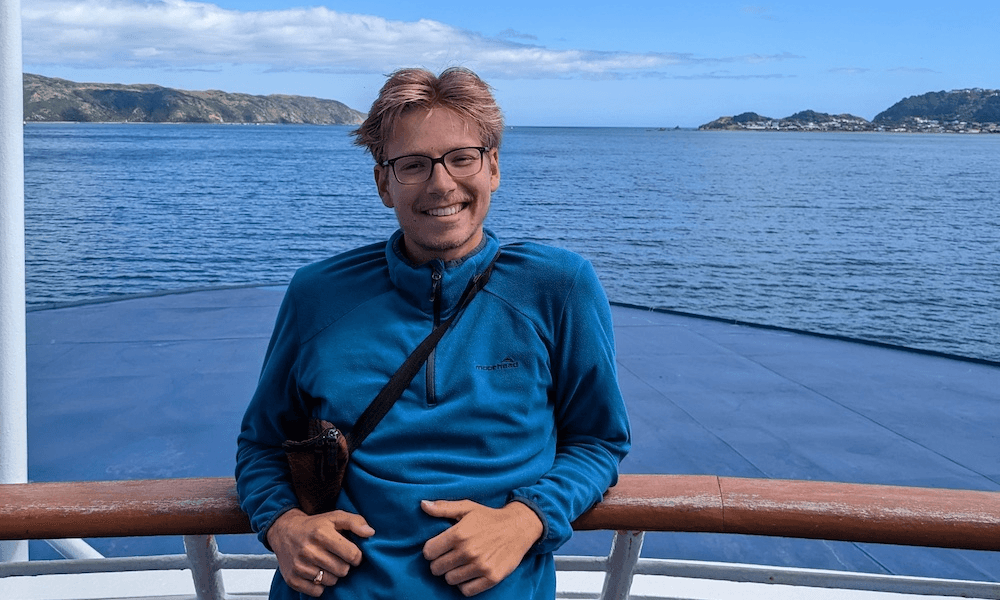
Arne (Photo: Supplied)
Arne Schilling says New Zealand is a great place to hitchhike. The 19-year-old German student is on a gap year before he begins studying biochemistry at university. He arrived in New Zealand in October from near Hanover and has hitchhiked in both the North and South Islands on his own. He’s been picked up by a range of people, including one who was deeply into religion and prayed for him when he dropped him off. “That was nice.”
He rarely sees hitchhikers in Germany, but “after hitchhiking in New Zealand, I would definitely pick them up.”
Longest wait for a ride: “I had to walk for an hour. The place I wanted to get to was only 30 minutes away, so it was a short trip once someone stopped.”
Slightly scary story: “I was picked up by another German traveller. He wanted to do a short hike on the way. We had to travel along a very narrow, bumpy and steep road and the van’s transmission was playing up. I had visions of being stuck in a remote place without transport. Fortunately, he gave up on the plan and drove back to the main road. I was pretty relieved.”
Not all hitchhikers are young.
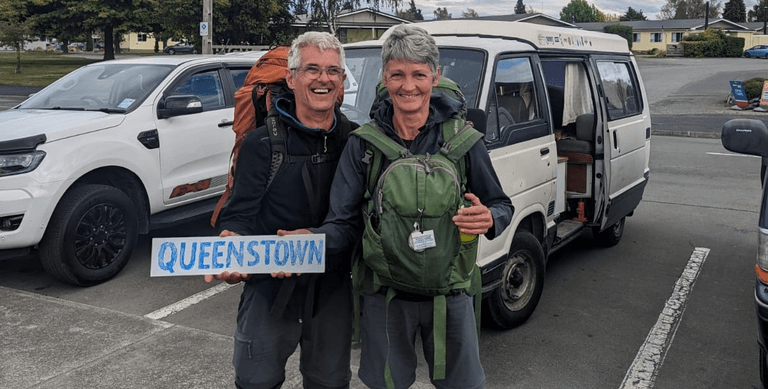
 Martine and Thierry (Photo: Supplied)
Martine and Thierry (Photo: Supplied)
Martine Poitevin from Brittany in France is 63. This is the third time she has hitchhiked in New Zealand. Her first visit was in 1983 when she was on a six-month working holiday. She returned with her husband Thierry in 2001. A former B&B owner, she is now retired. Thierry is a signwriter, which is useful when they indicate to passing drivers where they are headed. They sleep in camping grounds. “The cost of living is expensive in New Zealand, especially accommodation, food and public transport.”
Best ride: “I once got a 1,000km ride in a long-distance lorry. I don’t think truck drivers are allowed to stop any more.”
On being a pensioner hitchhiking: “People are amazed we still do it, but I’ll continue to do it. It’s boring travelling by bus or train or even rental car. You don’t meet other people.”
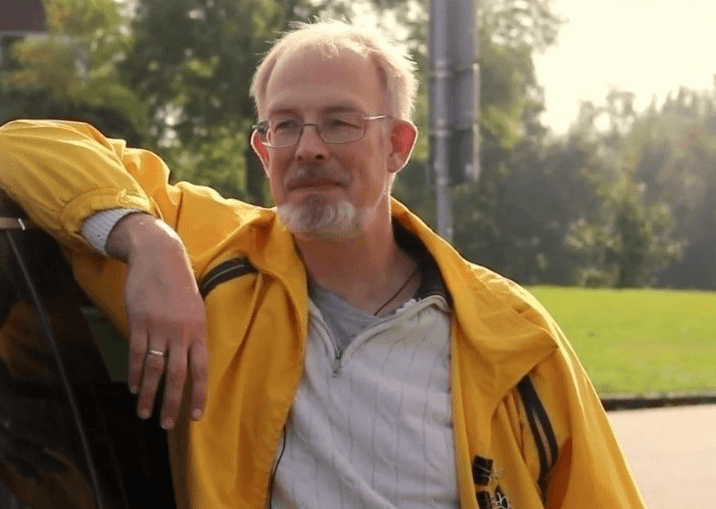
 Robert (Photo: Supplied)
Robert (Photo: Supplied)
Robert (“Prino”) Prins, 62, is known worldwide as the grandad of hitchhiking. He began hitchhiking when he was 18 and hasn’t stopped. He hasn’t been to New Zealand yet, but he has hitchhiked more than 687,528km in 33 countries. He holds a Guinness World Record for hitchhiking the longest distance in a day: 2318.4km from what was then southern Yugoslavia to just before Raststätte Hamburg-Stillhorn (Germany) on July 5, 1989. It took four rides.
When I spoke to him he was visiting his home country, the Netherlands, to see his parents. He says he is definitely considered a “bit strange” for still hitchhiking in his 60s. “Hitchhiking is vastly different now from when I started more than 40 years ago. There are far fewer hitchhikers. Many of them live alternative lifestyles, outside of mainstream society: squatters, dumpster divers, climate activists. It’s pretty rare to see people over 30-35.”
He says drivers who pick him up are still the same but there is more talk about presumed dangers. But he doesn’t believe the risks have changed. “Things are getting easier for me. As an ‘old man’ I may be seen as less of a threat, and many people are curious as to why I still hitchhike.”
The grandfather of four, who speaks three languages, met his wife at a hitchhikers’ gathering. They have hitchhiked together, but “she prefers a warm room and a soft bed now”.
Speediest ride: 196.1kph in Germany. “I also travelled in a vehicle that briefly reached 300kph. It was prevented from going faster because of an increased density in traffic.”
Why hitchhike? “I just like meeting people from all walks of life, from people really high up to your average Tom/Tammy, Dick/Deirdre, or Harry/Harriet to petty criminals who offer you ‘jobs’. I simply like doing it, and appreciate it when people tell me that they had a great time listening to my stories to kill the time during long(er) rides. Someone called me a kind of modern day court-jester once.”
Bad experiences: “One driver put his hand on my leg and squeezed it during my very first trip in 1980; another fell asleep when I was also sleeping in 1987 and parked the car sideways on the crash barrier in the middle of the motorway. There are plenty of people at the far ends of the political spectrum, and a fair share of fanatical religious people.”
Longest wait for a ride: “Nine hours 35 minutes in 1982 in Kautokeino, in Norway, whereupon I took a bus.”
So, will hitchhiking ever make a meaningful comeback?
Some people think there will need to be a massive societal shift towards trusting people for that to happen. Anthropologist Patrick Laviolette, a professor at Masaryk University in the Czech Republic, where hitchhiking is still common, writes in his book Hitchhiking: Cultural Inroads that in recent decades, as western culture has become increasingly individualistic, both drivers and travellers in the US and Europe have grown warier of sharing rides.
Robert Prino also doesn’t think the golden age will return because young people can’t be arsed waiting for a ride. “Many young people want it all and they want it now and spending up to six days standing at the side of the road when going from one place to another is not done when you can fly there in just a couple of hours, probably even cheaper than by using your thumb. I’ve flown from Vilnius in Lithuania to Eindhoven in the Netherlands a few times for €20 ($34.80), and with a coffee on the motorway in most of western Europe priced at €3 ($5.22) and over, and a cup of soup on the Autobahn at €7 ($12.18), that explains it.”
Which brings us back to the 50-year-old at the wedding party, who says he has never lost his passion for sticking out his thumb.
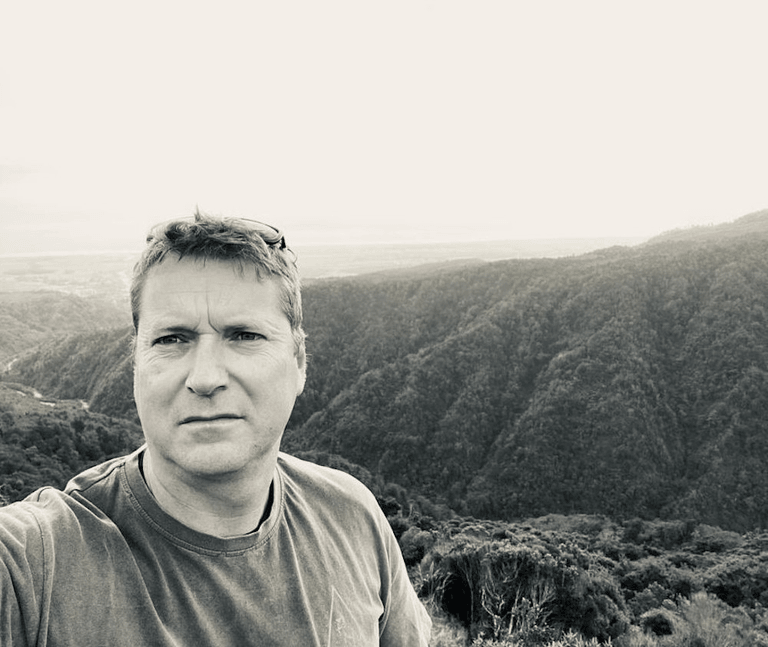
 Corran (Photo: Supplied)
Corran (Photo: Supplied)
Corran Roberts began hitchhiking when he was 14. He was at a loose end at the beginning of the school holidays and his mother said, “Why don’t you hitchhike around the North Island?” So he did, with a mate. “I don’t think people knew how old I was. I had long hair, probably looked older.” They had fun and the spirit never left him. When he and his wife, Joanne, were based in London, they hitchhiked in Iceland at the start of the aurora borealis (Northern Lights). “We got dropped off just outside Reykjavik near a lake with icebergs. It was so cold and that night the tent got flattened. Jo never hitchhiked again.”
He has hitchhiked many times since. Once he was picked up on a gravel road at Ōpito Bay, on the Coromandel Peninsula, and driven more than 200km to his workplace in Auckland.
The last time he hitchhiked was of necessity. He was stopped by a cop for speeding near Te Kūiti and his licence had expired. Prevented from carrying on, he parked his car at a service station and put out his thumb. It was dark in the middle of winter. “But I got a ride in two minutes.”
13–16 minutes

Once upon a time, a generation of free-spirited travellers thumbed their way around the world. In this risk-averse age of instant gratification, does anyone still bother? Venetia Sherson finds out.
At an after-match party for a Coromandel wedding, the subject turned to hitchhiking. Several millennials were present. None had hitchhiked. Most couldn’t imagine why you would willingly get in a car with a stranger to reach your destination. Plus, they had their own wheels. But one man – a 50-year-old Auckland IT consultant – said he loved it, still did it, and would continue to put out his thumb when necessity or the spirit moved him. More about him later. But it raises the question: who else hitchhikes? And why?
Four decades ago, on every motorway junction stood a man or woman with a backpack and a piece of cardboard. New Zealanders on their OE were part of the thousands thumbing lifts on Europe’s roads. Mostly they were young travellers, on a quest to see as much of the world as possible for the lowest possible cost. The rules of engagement were clear: drivers provided free transport; hitchhikers provided company, conversation and tales from other lands. It was an altruistic transaction (possibly the last before words like “bludger” entered our lexicon) between those who had and those who had not.
By the late 1980s that changed. Far fewer travellers put their thumb out. In many parts of the world, hitchhiking appears to be the option of last resort. What killed the noble art?
Fear for starters.
In the act of putting out a thumb, a hiker puts themselves at the mercy of whoever stops to pick them up. The unpredictability of those encounters can be risky for drivers or passengers. Films like The Hitcher, a 1986 horror film about a psychopathic hitchhiker, spooked many drivers. The murders of hitchhikers here and overseas caused parents everywhere to caution their kids to take the bus or train instead. In Australia, Ivan Robert Marko Milat, known as “the backpacker murderer”, robbed and murdered seven backpackers between 1989 and 1992. The Guardian attributed the demise of hitchhiking to the murder in Britain in 1995 of 18-year-old French student Celine Figard.
In New Zealand, high-profile murders also had an impact. Tasmanian teacher Jennifer Beard was murdered in 1970 while hitchhiking to meet her boyfriend in Milford Sound. Mona Blades, 18, disappeared five years later while thumbing a lift from Napier to Tokoroa. Her body was never found. In all, eight people – three men and five women – have been murdered while hitchhiking in New Zealand in the past 50 years. New Zealand police advise against the practice – especially alone. At the inquest into the death of Czech hitchhiker Dagmar Pytlickova, killed travelling to Timaru in 2012, coroner Richard McElrea said, “For your own safety hitchhiking or accepting rides from people you don’t know is not recommended.”
Other factors have played a part. An increase in car ownership is one. New Zealand has one of the highest rates of car ownership in the world (92.1%). Given a fifth of the population are children, this is extraordinarily high. The first major purchase for millennials is a set of wheels, often paid for by their parents, who think it safer for their offspring to drive than take a bus, walk or stick out their thumb. The pandemic also put paid to hitchhiking in many countries. Britain banned the practice in 2020. Other countries strongly advised against car sharing to prevent the disease from spreading.
Long-distance truck drivers – once a godsend for hitchhikers – are also now largely banned from picking them up.
Then there’s the time factor. It can take a long time to get a ride on less busy roads, as Frenchman Cédric Rault-Verpre found when he tried to thumb a lift on New Zealand’s West Coast in 2016. After waiting four days sitting on his backpack, he took out his frustration on the Welcome to Punakaiki sign. He was billed $3,000 for the damage. In a hyper-connected age, where messages can be transmitted in seconds, the prospect of waiting for a lift for even 15 minutes may be too outmoded for younger people.
But the real reason may be more prosaic: with fewer people hitchhiking, the practice now seems strange; at odds with modern life. Whereas in the golden years hitchhiking depended on a sense of trust and mutuality, drivers today are warier. Hitchhikers are viewed with suspicion. They may be seen as bludgers, no different to beggars, exploiting the generosity of hard-working people.
So, has it gone forever? Apparently not in Aotearoa, which still gets the thumbs up as a destination on hitchwiki.org, a website dedicated to hitchhiking around the world.

Julie (Photo: Supplied)
Julie Goris is currently thumbing her way around New Zealand’s South Island and loving it. The 25-five-year old Belgian hitchhiker is a travel agent who speaks five languages. She spends half the year organising other people’s travel and the other half hitchhiking in countries she wants to experience for herself.
She arrived in New Zealand in March after hitchhiking in Chile and Argentina. Mostly, she has hitchhiked with a friend, but, in New Zealand, she has largely gone solo. “It’s not about getting a free ride any more. The stories and talks with people who pick me up are a really big part of travelling now.” Drivers who have picked her up include grandmothers, solo drivers who want company, an off-duty bus driver and people who have hitchhiked in the past themselves.
Mostly she has felt safe, “although there was a guy who kept telling me random murder stories, which was a bit weird”. She always asks where the driver is headed and, if she doesn’t like the look of them, she says she is going elsewhere. She also tells them she is being met at the other end.
Longest wait for a ride: One hour in the rain in Iceland.
Best story: “I was hitching in Portugal when I was around 19, travelling with a friend. We got dropped off at a small town with no accommodation so we had to carry on. Two cars stopped. One driver looked scary; the other nice, so we went with him. He said we should not be on the road as it was getting dark and we could stay at his place. He said he would take us to the local bar so people could vouch for his character. They did, including the bartender, who claimed she was a witch. We slept the night in his kids’ bedroom surrounded by pink castles and toys. He made a great Asian dinner for us and the next day put us back on the road again.”

Arne (Photo: Supplied)
Arne Schilling says New Zealand is a great place to hitchhike. The 19-year-old German student is on a gap year before he begins studying biochemistry at university. He arrived in New Zealand in October from near Hanover and has hitchhiked in both the North and South Islands on his own. He’s been picked up by a range of people, including one who was deeply into religion and prayed for him when he dropped him off. “That was nice.”
He rarely sees hitchhikers in Germany, but “after hitchhiking in New Zealand, I would definitely pick them up.”
Longest wait for a ride: “I had to walk for an hour. The place I wanted to get to was only 30 minutes away, so it was a short trip once someone stopped.”
Slightly scary story: “I was picked up by another German traveller. He wanted to do a short hike on the way. We had to travel along a very narrow, bumpy and steep road and the van’s transmission was playing up. I had visions of being stuck in a remote place without transport. Fortunately, he gave up on the plan and drove back to the main road. I was pretty relieved.”
Not all hitchhikers are young.

Martine Poitevin from Brittany in France is 63. This is the third time she has hitchhiked in New Zealand. Her first visit was in 1983 when she was on a six-month working holiday. She returned with her husband Thierry in 2001. A former B&B owner, she is now retired. Thierry is a signwriter, which is useful when they indicate to passing drivers where they are headed. They sleep in camping grounds. “The cost of living is expensive in New Zealand, especially accommodation, food and public transport.”
Best ride: “I once got a 1,000km ride in a long-distance lorry. I don’t think truck drivers are allowed to stop any more.”
On being a pensioner hitchhiking: “People are amazed we still do it, but I’ll continue to do it. It’s boring travelling by bus or train or even rental car. You don’t meet other people.”

Robert (“Prino”) Prins, 62, is known worldwide as the grandad of hitchhiking. He began hitchhiking when he was 18 and hasn’t stopped. He hasn’t been to New Zealand yet, but he has hitchhiked more than 687,528km in 33 countries. He holds a Guinness World Record for hitchhiking the longest distance in a day: 2318.4km from what was then southern Yugoslavia to just before Raststätte Hamburg-Stillhorn (Germany) on July 5, 1989. It took four rides.
When I spoke to him he was visiting his home country, the Netherlands, to see his parents. He says he is definitely considered a “bit strange” for still hitchhiking in his 60s. “Hitchhiking is vastly different now from when I started more than 40 years ago. There are far fewer hitchhikers. Many of them live alternative lifestyles, outside of mainstream society: squatters, dumpster divers, climate activists. It’s pretty rare to see people over 30-35.”
He says drivers who pick him up are still the same but there is more talk about presumed dangers. But he doesn’t believe the risks have changed. “Things are getting easier for me. As an ‘old man’ I may be seen as less of a threat, and many people are curious as to why I still hitchhike.”
The grandfather of four, who speaks three languages, met his wife at a hitchhikers’ gathering. They have hitchhiked together, but “she prefers a warm room and a soft bed now”.
Speediest ride: 196.1kph in Germany. “I also travelled in a vehicle that briefly reached 300kph. It was prevented from going faster because of an increased density in traffic.”
Why hitchhike? “I just like meeting people from all walks of life, from people really high up to your average Tom/Tammy, Dick/Deirdre, or Harry/Harriet to petty criminals who offer you ‘jobs’. I simply like doing it, and appreciate it when people tell me that they had a great time listening to my stories to kill the time during long(er) rides. Someone called me a kind of modern day court-jester once.”
Bad experiences: “One driver put his hand on my leg and squeezed it during my very first trip in 1980; another fell asleep when I was also sleeping in 1987 and parked the car sideways on the crash barrier in the middle of the motorway. There are plenty of people at the far ends of the political spectrum, and a fair share of fanatical religious people.”
Longest wait for a ride: “Nine hours 35 minutes in 1982 in Kautokeino, in Norway, whereupon I took a bus.”
So, will hitchhiking ever make a meaningful comeback?
Some people think there will need to be a massive societal shift towards trusting people for that to happen. Anthropologist Patrick Laviolette, a professor at Masaryk University in the Czech Republic, where hitchhiking is still common, writes in his book Hitchhiking: Cultural Inroads that in recent decades, as western culture has become increasingly individualistic, both drivers and travellers in the US and Europe have grown warier of sharing rides.
Robert Prino also doesn’t think the golden age will return because young people can’t be arsed waiting for a ride. “Many young people want it all and they want it now and spending up to six days standing at the side of the road when going from one place to another is not done when you can fly there in just a couple of hours, probably even cheaper than by using your thumb. I’ve flown from Vilnius in Lithuania to Eindhoven in the Netherlands a few times for €20 ($34.80), and with a coffee on the motorway in most of western Europe priced at €3 ($5.22) and over, and a cup of soup on the Autobahn at €7 ($12.18), that explains it.”
Which brings us back to the 50-year-old at the wedding party, who says he has never lost his passion for sticking out his thumb.

Corran Roberts began hitchhiking when he was 14. He was at a loose end at the beginning of the school holidays and his mother said, “Why don’t you hitchhike around the North Island?” So he did, with a mate. “I don’t think people knew how old I was. I had long hair, probably looked older.” They had fun and the spirit never left him. When he and his wife, Joanne, were based in London, they hitchhiked in Iceland at the start of the aurora borealis (Northern Lights). “We got dropped off just outside Reykjavik near a lake with icebergs. It was so cold and that night the tent got flattened. Jo never hitchhiked again.”
He has hitchhiked many times since. Once he was picked up on a gravel road at Ōpito Bay, on the Coromandel Peninsula, and driven more than 200km to his workplace in Auckland.
The last time he hitchhiked was of necessity. He was stopped by a cop for speeding near Te Kūiti and his licence had expired. Prevented from carrying on, he parked his car at a service station and put out his thumb. It was dark in the middle of winter. “But I got a ride in two minutes.”



